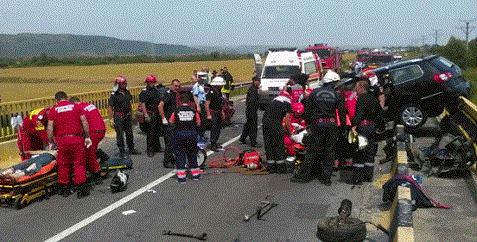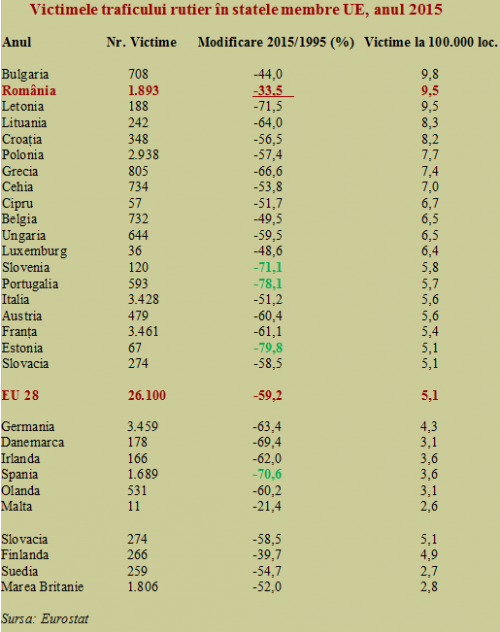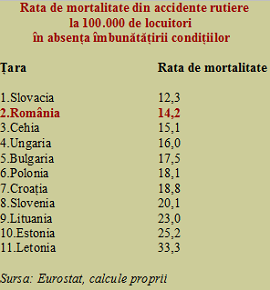 The dozens of deaths on Romania’s roads from the recent weeks – be it the chain accidents on the Sun Motorway or those on DN2 and DN6 occurred during the last weekend – remind us of the dark statistics that we hold in the European rankings.
The dozens of deaths on Romania’s roads from the recent weeks – be it the chain accidents on the Sun Motorway or those on DN2 and DN6 occurred during the last weekend – remind us of the dark statistics that we hold in the European rankings.
Romania ranked the second last year in the EU, along with Latvia, by the number of victims of road accidents to the total population, namely 9.5 people per hundred thousand inhabitants.
According to the data released late last week by Euroastat, we also rank the second by the lowest mortality reduction over the past 20 years.
That is strictly at the first sight: because the gap to the leader of mortality on the European roads, Bulgaria, is very narrow (Bulgarians had 9.8 to 100,000) and given the high number of Romanians from abroad, we rank the first de facto. Besides, figures representing the mortality reduction in the last 20 years for Malta (11 vs. 14 deaths) are practically irrelevant, especially since the small Mediterranean state is doing in fact the best by the key indicator.
So, if we also look at Bulgarians’ pace of mortality reduction by more than one third, we can consider ourselves the red flashlight in terms of road safety improvement in the EU.
More specifically, one Romanian in ten thousand dies in road accidents annually, given that if we had followed the Spanish model (not to say the Portuguese performance), we would have now ranked just below Germany, like the Spanish.
*
Traffic accidents victims in the EU states, in 2015
Year No of victims Change 2015/1995 (%) No of victims to 100,000 inhabitants
Source: Eurostat
*
Incidentally, given that at the European level people die, according to the official figures, 92 times less frequently in plane crashes than on roads and 27 times less frequently in railway accidents, maybe we should have paid an entirely different attention at national level to the internal air flights and the development of a high-speed rail network, even before the great epics of the highway construction.
Where we started and some conclusions
If we process the Eurostat data to track the effort that former socialist states, now EU members, made over the last 20 years for reducing the number of victims of road accidents and calculate what the mortality rate would be now if no improvement was made since two decades ago, we find that we also started in 1995 from the 2nd position, but in a positive, not negative way, the same as we are now, after we stagnated relative to the countries in the region.
Mortality rate in road accidents to 100,000 inhabitants, in the absence of any improvement of conditions
Country Mortality rate
Source: Eurostat, own calculations
*
This is also the main reason why we approached this subject, apparently placed outside the economic problems that Romania is facing. In this transfer from the leading 2nd to the 2nd to last position we find the overview of the evolution of the social areas involved (road education, healthcare system, public safety and administrative coordination), that is the state’s interest toward the citizens.
Before we get to benefit from the economic growth and social services at the European standards, we should arrive safely at our destination either by our private cars or bus.
The road matter where, says Eurostat, we are almost the worst and we did the least efforts to be better in the last two decades. The higher number of cars, obsolete fleet, bad roads and poor healthcare system, especially in the provinces could be mentioned as reasons. The same as we could ask ourselves a serious question about where we would have been now without the development of SMURD service.
Perhaps it would be useful to look carefully at Spain’s example, our Latin sister, which shows that the economy is not necessarily a precondition for improving the road safety. Following an effort between 1995 and 2015 to decrease by 70% the number of victims in accidents (exactly the opposite to our just 33.5%), Spaniards reached a mortality rate even below Germany.
So, until the convergence of GDP / capita or purchasing power, maybe we should be aware that economic indicators are not an end purpose in itself, but should serve a purpose. Otherwise they remain only on paper, a paper that can be even a death certificate.











